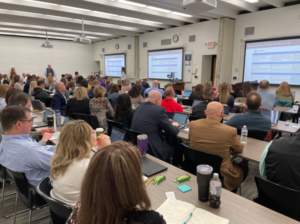The disruptive power of learning technology
Had a little sidebar in the NYTimes Magazine this morning. There were supposed to be a dozen short responses to “What is the most important – or hardest – thing to change in education today and how would you change it?” Sounds like the piece got axed with just a couple sidebars making today’s paper. My original June response to this question follows.
American education is a Gordian knot of local employment contracts intertwined with local, state, and federal policy. Equally knotty is our collective and idealized (or traumatized) memories of school. The combination has locked in place an ineffective, expensive, and inequitable ‘system’ of primary and secondary education. I spent 15 years as a superintendent, grant maker and non-profit executive working on the knot with limited success. It’s a tough problem.
Technology has proven to be a disruptive force in most other sectors of society. It transformed communications, drove efficiency in retail, and helped Obama get elected. Because education is largely protected from incentives and consequences, it lags the rest of the economy by a decade in adoption of new technology—but it’s coming, and coming fast.
This summer I visited a New York City pilot program called School of One—a radically personalized vision of education where every student has a daily ‘play list’ tailored their instructional level, interests, and learning style. It blends online learning, small group sessions, and one-on-one tutoring in an engaging experiment. It’s a vivid picture of the shift from age cohorts slogging through a textbook to personalized digital learning services.
This fall, about two million kids K-12 students will be learning online at home and at school (about 4%). By the end of the next decade, most American high school students will do most of their learning online. It shouldn’t take that long but it will.
New tools are making possible a new generation of schools that blend the best of online and onsite learning. They incorporate social learning networks (i.e., Facebook for school), personalized content (curriculum customized by level and best modality), and learning games. An increasing number will be charter schools free of some local bureaucracy (but still bound by restrictive state policies). They will be more productive, less expensive, and more fun!
The disruptive potential of technology for excellence and equity is why I’m investing in and advocating for innovative learning tools and schools.








0 Comments
Leave a Comment
Your email address will not be published. All fields are required.